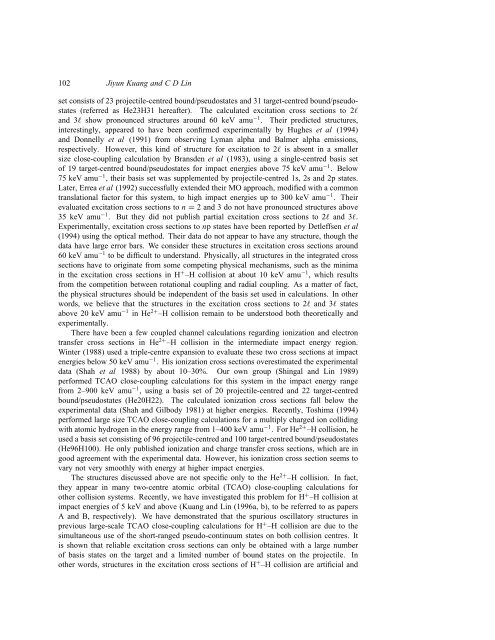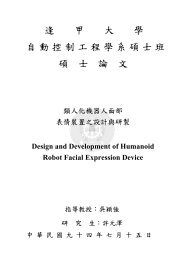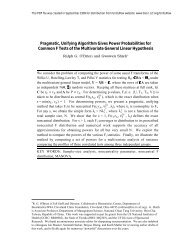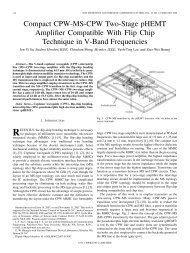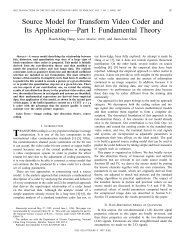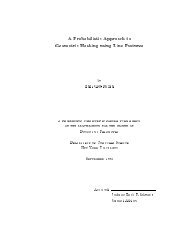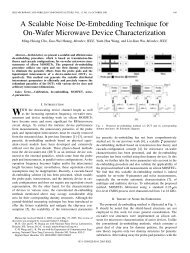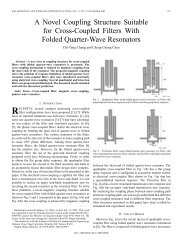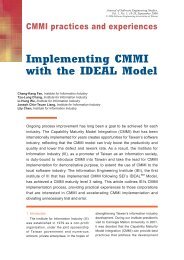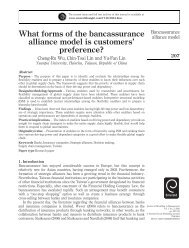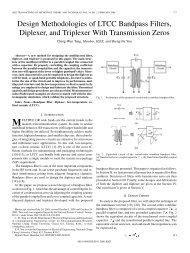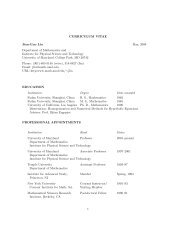J. Phys. B: At. Mol. Opt. Phys. 30
J. Phys. B: At. Mol. Opt. Phys. 30
J. Phys. B: At. Mol. Opt. Phys. 30
You also want an ePaper? Increase the reach of your titles
YUMPU automatically turns print PDFs into web optimized ePapers that Google loves.
102 Jiyun Kuang and CDLin<br />
set consists of 23 projectile-centred bound/pseudostates and 31 target-centred bound/pseudostates<br />
(referred as He23H31 hereafter). The calculated excitation cross sections to 2l<br />
and 3l show pronounced structures around 60 keV amu −1 . Their predicted structures,<br />
interestingly, appeared to have been confirmed experimentally by Hughes et al (1994)<br />
and Donnelly et al (1991) from observing Lyman alpha and Balmer alpha emissions,<br />
respectively. However, this kind of structure for excitation to 2l is absent in a smaller<br />
size close-coupling calculation by Bransden et al (1983), using a single-centred basis set<br />
of 19 target-centred bound/pseudostates for impact energies above 75 keV amu −1 . Below<br />
75 keV amu −1 , their basis set was supplemented by projectile-centred 1s, 2s and 2p states.<br />
Later, Errea et al (1992) successfully extended their MO approach, modified with a common<br />
translational factor for this system, to high impact energies up to <strong>30</strong>0 keV amu −1 . Their<br />
evaluated excitation cross sections to n = 2 and 3 do not have pronounced structures above<br />
35 keV amu −1 . But they did not publish partial excitation cross sections to 2l and 3l.<br />
Experimentally, excitation cross sections to np states have been reported by Detleffsen et al<br />
(1994) using the optical method. Their data do not appear to have any structure, though the<br />
data have large error bars. We consider these structures in excitation cross sections around<br />
60 keV amu −1 to be difficult to understand. <strong>Phys</strong>ically, all structures in the integrated cross<br />
sections have to originate from some competing physical mechanisms, such as the minima<br />
in the excitation cross sections in H + –H collision at about 10 keV amu −1 , which results<br />
from the competition between rotational coupling and radial coupling. As a matter of fact,<br />
the physical structures should be independent of the basis set used in calculations. In other<br />
words, we believe that the structures in the excitation cross sections to 2l and 3l states<br />
above 20 keV amu −1 in He 2+ –H collision remain to be understood both theoretically and<br />
experimentally.<br />
There have been a few coupled channel calculations regarding ionization and electron<br />
transfer cross sections in He 2+ –H collision in the intermediate impact energy region.<br />
Winter (1988) used a triple-centre expansion to evaluate these two cross sections at impact<br />
energies below 50 keV amu −1 . His ionization cross sections overestimated the experimental<br />
data (Shah et al 1988) by about 10–<strong>30</strong>%. Our own group (Shingal and Lin 1989)<br />
performed TCAO close-coupling calculations for this system in the impact energy range<br />
from 2–900 keV amu −1 , using a basis set of 20 projectile-centred and 22 target-centred<br />
bound/pseudostates (He20H22). The calculated ionization cross sections fall below the<br />
experimental data (Shah and Gilbody 1981) at higher energies. Recently, Toshima (1994)<br />
performed large size TCAO close-coupling calculations for a multiply charged ion colliding<br />
with atomic hydrogen in the energy range from 1–400 keV amu −1 . For He 2+ –H collision, he<br />
used a basis set consisting of 96 projectile-centred and 100 target-centred bound/pseudostates<br />
(He96H100). He only published ionization and charge transfer cross sections, which are in<br />
good agreement with the experimental data. However, his ionization cross section seems to<br />
vary not very smoothly with energy at higher impact energies.<br />
The structures discussed above are not specific only to the He 2+ –H collision. In fact,<br />
they appear in many two-centre atomic orbital (TCAO) close-coupling calculations for<br />
other collision systems. Recently, we have investigated this problem for H + –H collision at<br />
impact energies of 5 keV and above (Kuang and Lin (1996a, b), to be referred to as papers<br />
A and B, respectively). We have demonstrated that the spurious oscillatory structures in<br />
previous large-scale TCAO close-coupling calculations for H + –H collision are due to the<br />
simultaneous use of the short-ranged pseudo-continuum states on both collision centres. It<br />
is shown that reliable excitation cross sections can only be obtained with a large number<br />
of basis states on the target and a limited number of bound states on the projectile. In<br />
other words, structures in the excitation cross sections of H + –H collision are artificial and


